Hull University: Training Needs of School Lunchtime Supervisors
VerifiedAdded on 2023/06/08
|9
|2481
|333
Report
AI Summary
This report investigates the training and learning needs of school lunchtime supervisors, focusing on a case study commissioned by the University of Hull. The study addresses the lack of qualified supervisors and emphasizes the importance of effective training programs. The report outlines key features of training programs, aligning with UK government guidance on safeguarding children, and explores creative techniques to enhance future training initiatives for government employees. It also delves into the role of Human Resource Management (HRM) and Human Resource Development (HRD) practices in contributing to individual and organizational performance, highlighting the value of training for various stakeholders, including supervisors, students, and the organization. The report underscores the significance of employee engagement, innovation, and creating a supportive environment to improve the overall effectiveness of lunchtime supervisors and enhance their ability to manage and safeguard children during school breaks. The report concludes with a call for the HR department to gain insights into the training needs analysis effectively, ensuring the well-being of children and the success of training programs.
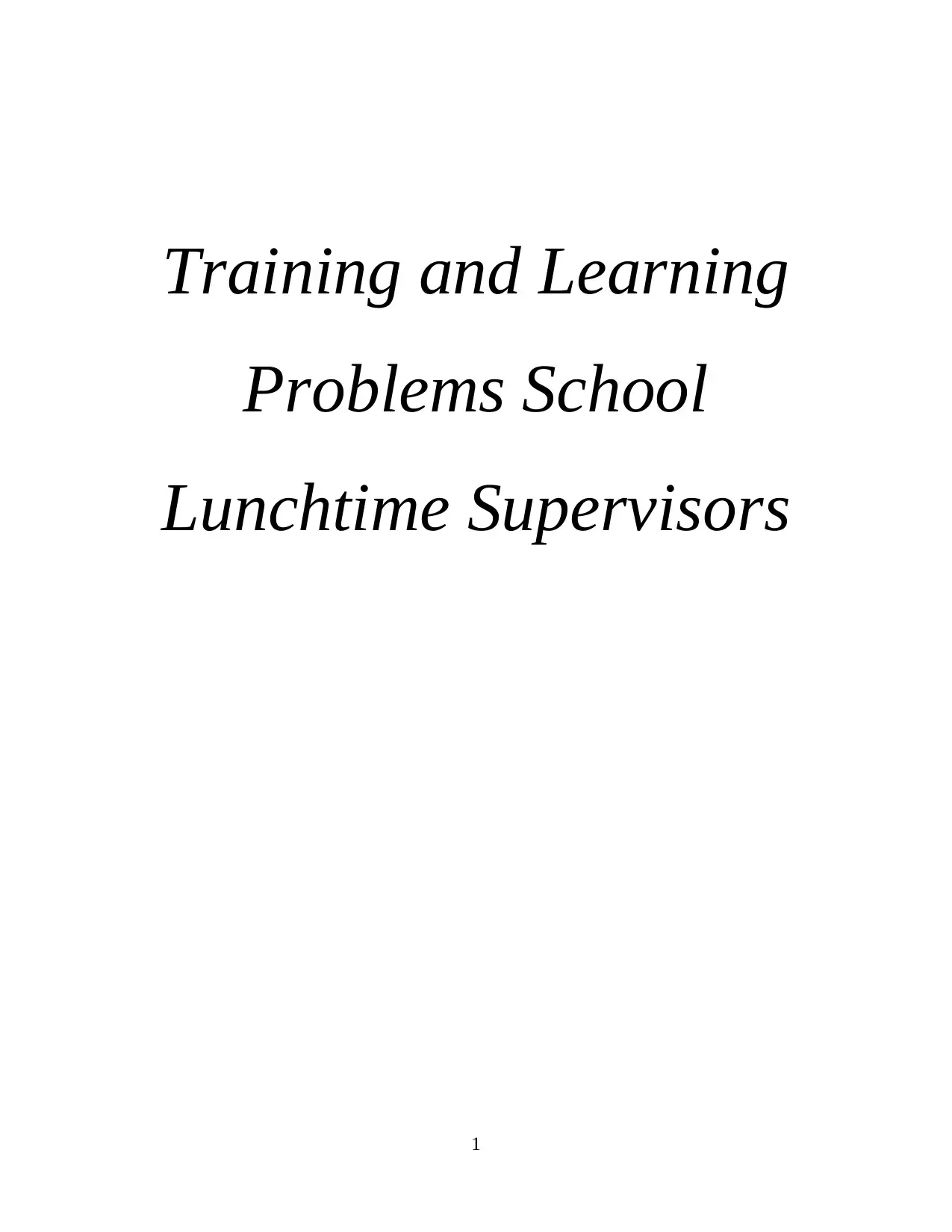
Training and Learning
Problems School
Lunchtime Supervisors
1
Problems School
Lunchtime Supervisors
1
Paraphrase This Document
Need a fresh take? Get an instant paraphrase of this document with our AI Paraphraser
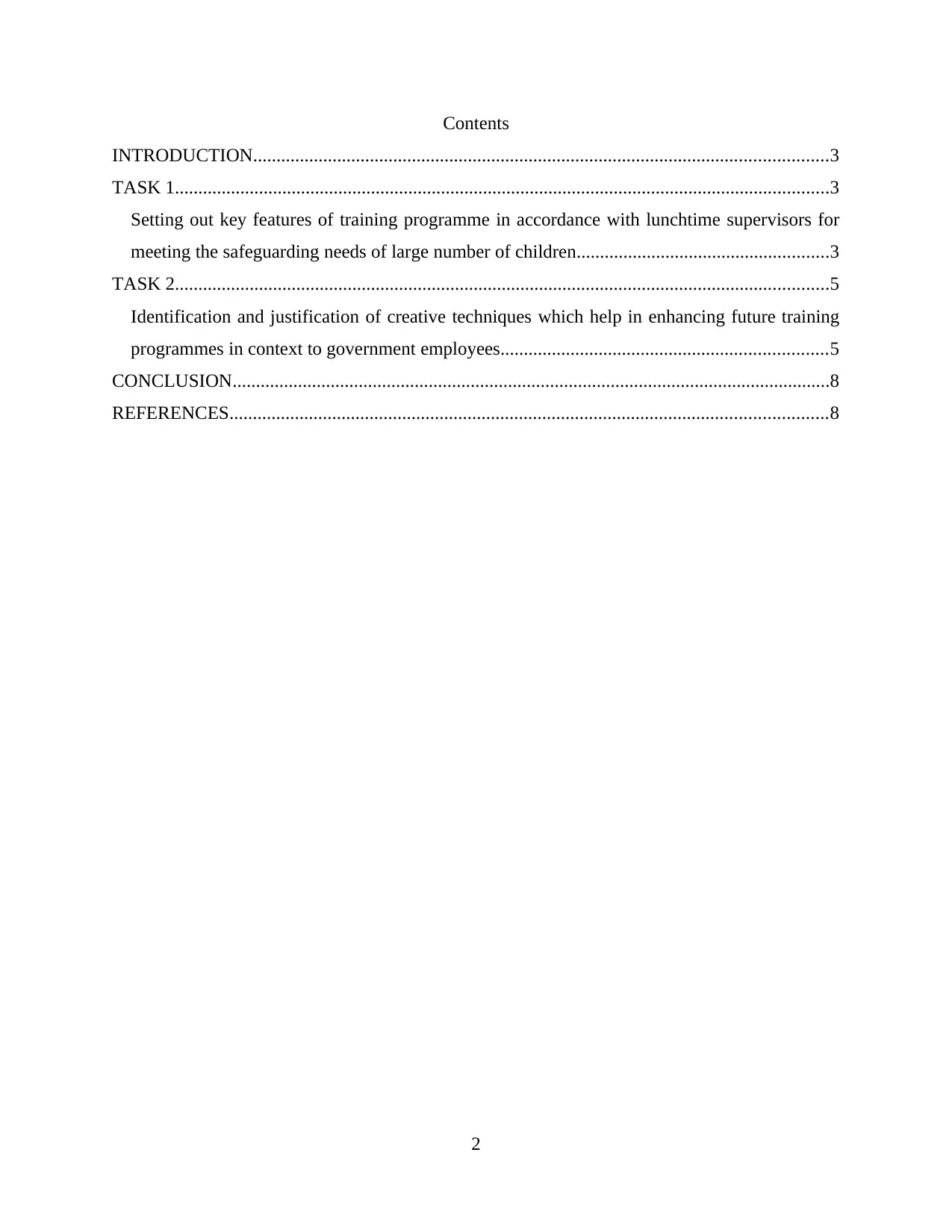
Contents
INTRODUCTION...........................................................................................................................3
TASK 1............................................................................................................................................3
Setting out key features of training programme in accordance with lunchtime supervisors for
meeting the safeguarding needs of large number of children......................................................3
TASK 2............................................................................................................................................5
Identification and justification of creative techniques which help in enhancing future training
programmes in context to government employees......................................................................5
CONCLUSION................................................................................................................................8
REFERENCES................................................................................................................................8
2
INTRODUCTION...........................................................................................................................3
TASK 1............................................................................................................................................3
Setting out key features of training programme in accordance with lunchtime supervisors for
meeting the safeguarding needs of large number of children......................................................3
TASK 2............................................................................................................................................5
Identification and justification of creative techniques which help in enhancing future training
programmes in context to government employees......................................................................5
CONCLUSION................................................................................................................................8
REFERENCES................................................................................................................................8
2
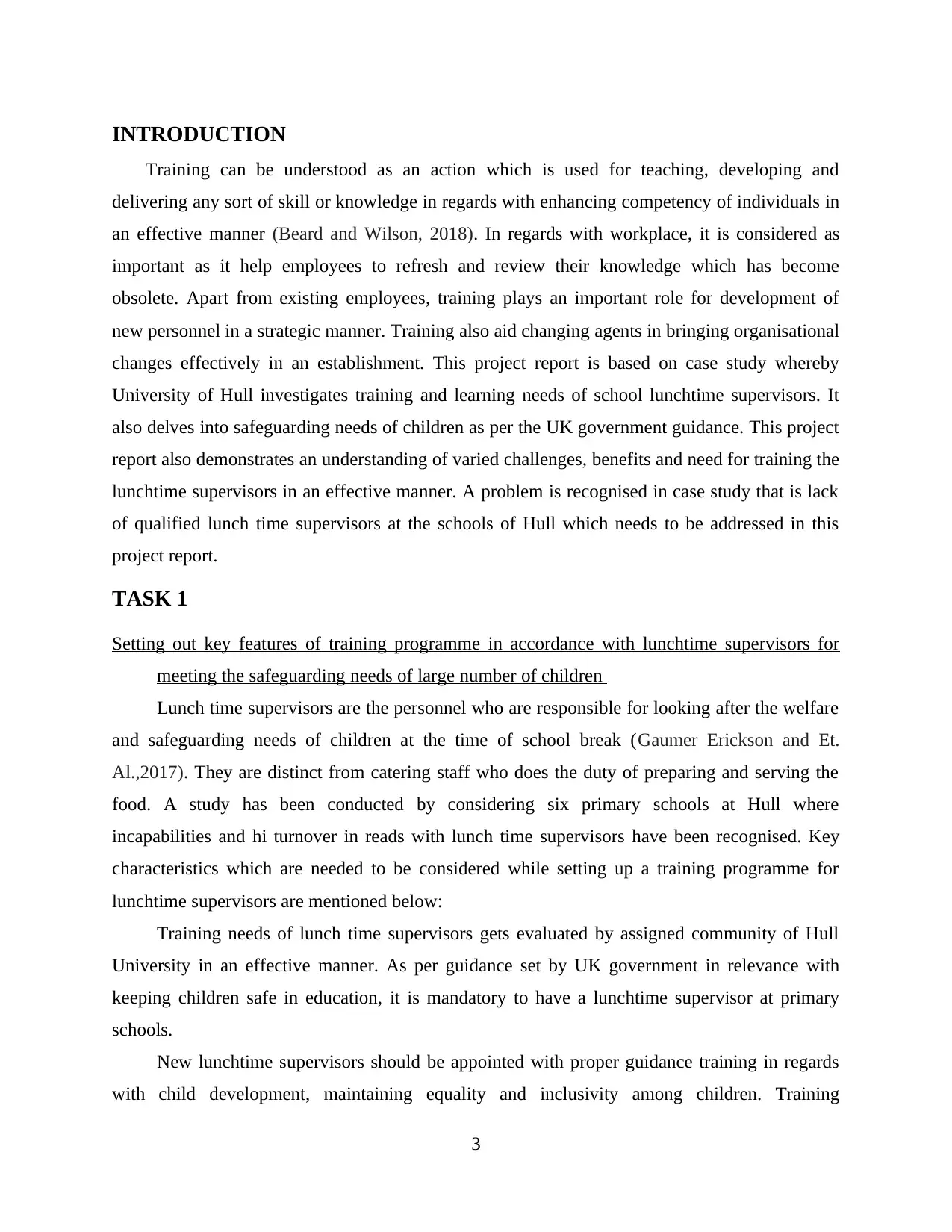
INTRODUCTION
Training can be understood as an action which is used for teaching, developing and
delivering any sort of skill or knowledge in regards with enhancing competency of individuals in
an effective manner (Beard and Wilson, 2018). In regards with workplace, it is considered as
important as it help employees to refresh and review their knowledge which has become
obsolete. Apart from existing employees, training plays an important role for development of
new personnel in a strategic manner. Training also aid changing agents in bringing organisational
changes effectively in an establishment. This project report is based on case study whereby
University of Hull investigates training and learning needs of school lunchtime supervisors. It
also delves into safeguarding needs of children as per the UK government guidance. This project
report also demonstrates an understanding of varied challenges, benefits and need for training the
lunchtime supervisors in an effective manner. A problem is recognised in case study that is lack
of qualified lunch time supervisors at the schools of Hull which needs to be addressed in this
project report.
TASK 1
Setting out key features of training programme in accordance with lunchtime supervisors for
meeting the safeguarding needs of large number of children
Lunch time supervisors are the personnel who are responsible for looking after the welfare
and safeguarding needs of children at the time of school break (Gaumer Erickson and Et.
Al.,2017). They are distinct from catering staff who does the duty of preparing and serving the
food. A study has been conducted by considering six primary schools at Hull where
incapabilities and hi turnover in reads with lunch time supervisors have been recognised. Key
characteristics which are needed to be considered while setting up a training programme for
lunchtime supervisors are mentioned below:
Training needs of lunch time supervisors gets evaluated by assigned community of Hull
University in an effective manner. As per guidance set by UK government in relevance with
keeping children safe in education, it is mandatory to have a lunchtime supervisor at primary
schools.
New lunchtime supervisors should be appointed with proper guidance training in regards
with child development, maintaining equality and inclusivity among children. Training
3
Training can be understood as an action which is used for teaching, developing and
delivering any sort of skill or knowledge in regards with enhancing competency of individuals in
an effective manner (Beard and Wilson, 2018). In regards with workplace, it is considered as
important as it help employees to refresh and review their knowledge which has become
obsolete. Apart from existing employees, training plays an important role for development of
new personnel in a strategic manner. Training also aid changing agents in bringing organisational
changes effectively in an establishment. This project report is based on case study whereby
University of Hull investigates training and learning needs of school lunchtime supervisors. It
also delves into safeguarding needs of children as per the UK government guidance. This project
report also demonstrates an understanding of varied challenges, benefits and need for training the
lunchtime supervisors in an effective manner. A problem is recognised in case study that is lack
of qualified lunch time supervisors at the schools of Hull which needs to be addressed in this
project report.
TASK 1
Setting out key features of training programme in accordance with lunchtime supervisors for
meeting the safeguarding needs of large number of children
Lunch time supervisors are the personnel who are responsible for looking after the welfare
and safeguarding needs of children at the time of school break (Gaumer Erickson and Et.
Al.,2017). They are distinct from catering staff who does the duty of preparing and serving the
food. A study has been conducted by considering six primary schools at Hull where
incapabilities and hi turnover in reads with lunch time supervisors have been recognised. Key
characteristics which are needed to be considered while setting up a training programme for
lunchtime supervisors are mentioned below:
Training needs of lunch time supervisors gets evaluated by assigned community of Hull
University in an effective manner. As per guidance set by UK government in relevance with
keeping children safe in education, it is mandatory to have a lunchtime supervisor at primary
schools.
New lunchtime supervisors should be appointed with proper guidance training in regards
with child development, maintaining equality and inclusivity among children. Training
3
⊘ This is a preview!⊘
Do you want full access?
Subscribe today to unlock all pages.

Trusted by 1+ million students worldwide
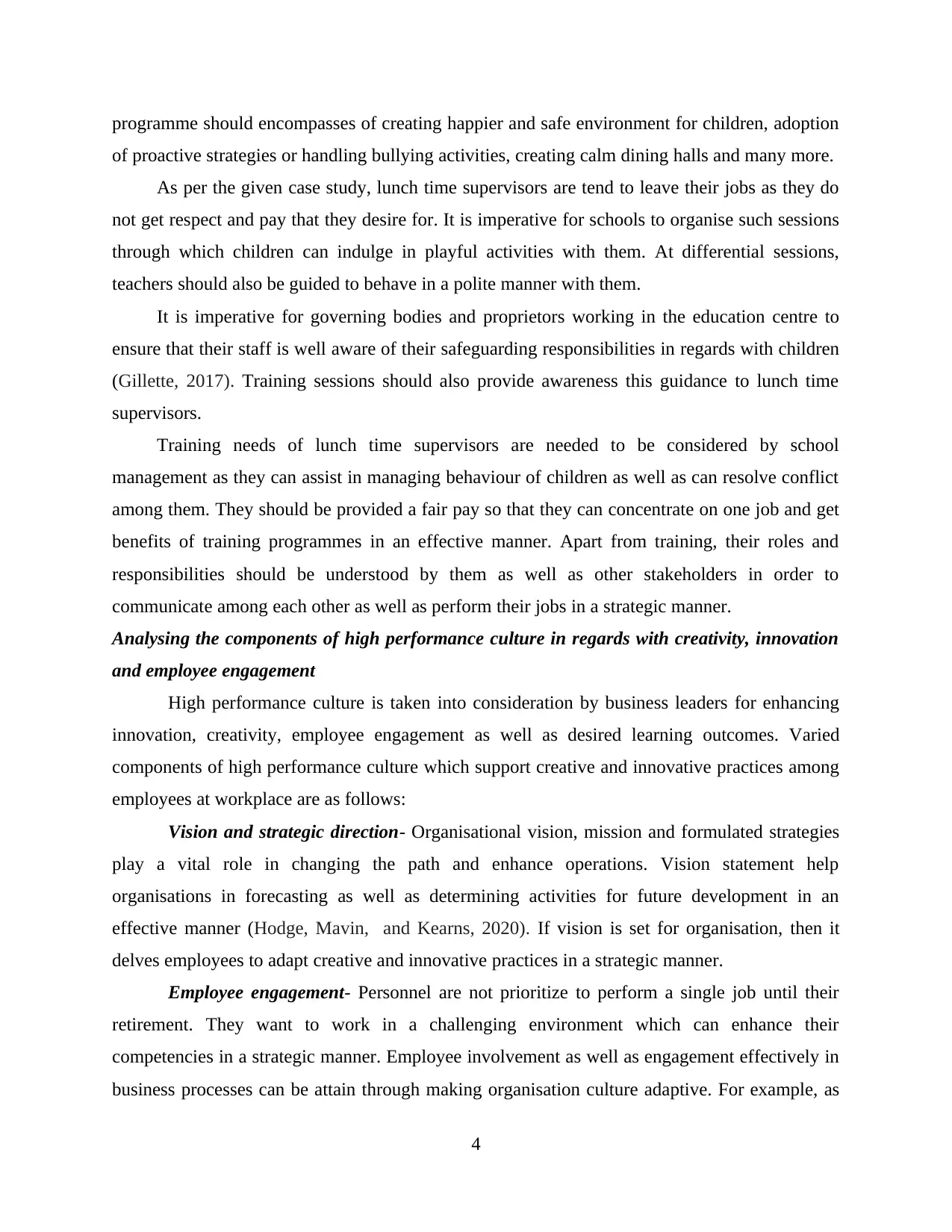
programme should encompasses of creating happier and safe environment for children, adoption
of proactive strategies or handling bullying activities, creating calm dining halls and many more.
As per the given case study, lunch time supervisors are tend to leave their jobs as they do
not get respect and pay that they desire for. It is imperative for schools to organise such sessions
through which children can indulge in playful activities with them. At differential sessions,
teachers should also be guided to behave in a polite manner with them.
It is imperative for governing bodies and proprietors working in the education centre to
ensure that their staff is well aware of their safeguarding responsibilities in regards with children
(Gillette, 2017). Training sessions should also provide awareness this guidance to lunch time
supervisors.
Training needs of lunch time supervisors are needed to be considered by school
management as they can assist in managing behaviour of children as well as can resolve conflict
among them. They should be provided a fair pay so that they can concentrate on one job and get
benefits of training programmes in an effective manner. Apart from training, their roles and
responsibilities should be understood by them as well as other stakeholders in order to
communicate among each other as well as perform their jobs in a strategic manner.
Analysing the components of high performance culture in regards with creativity, innovation
and employee engagement
High performance culture is taken into consideration by business leaders for enhancing
innovation, creativity, employee engagement as well as desired learning outcomes. Varied
components of high performance culture which support creative and innovative practices among
employees at workplace are as follows:
Vision and strategic direction- Organisational vision, mission and formulated strategies
play a vital role in changing the path and enhance operations. Vision statement help
organisations in forecasting as well as determining activities for future development in an
effective manner (Hodge, Mavin, and Kearns, 2020). If vision is set for organisation, then it
delves employees to adapt creative and innovative practices in a strategic manner.
Employee engagement- Personnel are not prioritize to perform a single job until their
retirement. They want to work in a challenging environment which can enhance their
competencies in a strategic manner. Employee involvement as well as engagement effectively in
business processes can be attain through making organisation culture adaptive. For example, as
4
of proactive strategies or handling bullying activities, creating calm dining halls and many more.
As per the given case study, lunch time supervisors are tend to leave their jobs as they do
not get respect and pay that they desire for. It is imperative for schools to organise such sessions
through which children can indulge in playful activities with them. At differential sessions,
teachers should also be guided to behave in a polite manner with them.
It is imperative for governing bodies and proprietors working in the education centre to
ensure that their staff is well aware of their safeguarding responsibilities in regards with children
(Gillette, 2017). Training sessions should also provide awareness this guidance to lunch time
supervisors.
Training needs of lunch time supervisors are needed to be considered by school
management as they can assist in managing behaviour of children as well as can resolve conflict
among them. They should be provided a fair pay so that they can concentrate on one job and get
benefits of training programmes in an effective manner. Apart from training, their roles and
responsibilities should be understood by them as well as other stakeholders in order to
communicate among each other as well as perform their jobs in a strategic manner.
Analysing the components of high performance culture in regards with creativity, innovation
and employee engagement
High performance culture is taken into consideration by business leaders for enhancing
innovation, creativity, employee engagement as well as desired learning outcomes. Varied
components of high performance culture which support creative and innovative practices among
employees at workplace are as follows:
Vision and strategic direction- Organisational vision, mission and formulated strategies
play a vital role in changing the path and enhance operations. Vision statement help
organisations in forecasting as well as determining activities for future development in an
effective manner (Hodge, Mavin, and Kearns, 2020). If vision is set for organisation, then it
delves employees to adapt creative and innovative practices in a strategic manner.
Employee engagement- Personnel are not prioritize to perform a single job until their
retirement. They want to work in a challenging environment which can enhance their
competencies in a strategic manner. Employee involvement as well as engagement effectively in
business processes can be attain through making organisation culture adaptive. For example, as
4
Paraphrase This Document
Need a fresh take? Get an instant paraphrase of this document with our AI Paraphraser
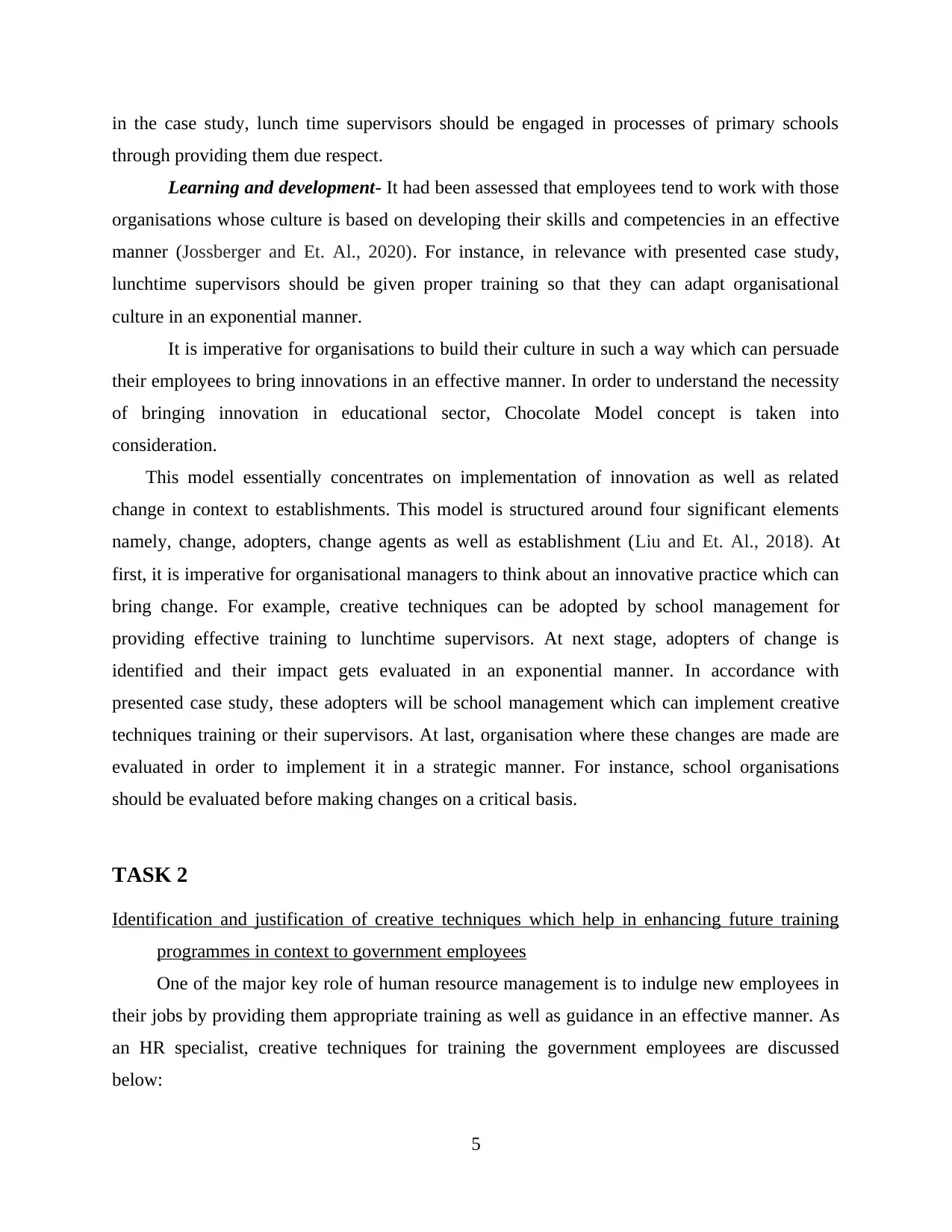
in the case study, lunch time supervisors should be engaged in processes of primary schools
through providing them due respect.
Learning and development- It had been assessed that employees tend to work with those
organisations whose culture is based on developing their skills and competencies in an effective
manner (Jossberger and Et. Al., 2020). For instance, in relevance with presented case study,
lunchtime supervisors should be given proper training so that they can adapt organisational
culture in an exponential manner.
It is imperative for organisations to build their culture in such a way which can persuade
their employees to bring innovations in an effective manner. In order to understand the necessity
of bringing innovation in educational sector, Chocolate Model concept is taken into
consideration.
This model essentially concentrates on implementation of innovation as well as related
change in context to establishments. This model is structured around four significant elements
namely, change, adopters, change agents as well as establishment (Liu and Et. Al., 2018). At
first, it is imperative for organisational managers to think about an innovative practice which can
bring change. For example, creative techniques can be adopted by school management for
providing effective training to lunchtime supervisors. At next stage, adopters of change is
identified and their impact gets evaluated in an exponential manner. In accordance with
presented case study, these adopters will be school management which can implement creative
techniques training or their supervisors. At last, organisation where these changes are made are
evaluated in order to implement it in a strategic manner. For instance, school organisations
should be evaluated before making changes on a critical basis.
TASK 2
Identification and justification of creative techniques which help in enhancing future training
programmes in context to government employees
One of the major key role of human resource management is to indulge new employees in
their jobs by providing them appropriate training as well as guidance in an effective manner. As
an HR specialist, creative techniques for training the government employees are discussed
below:
5
through providing them due respect.
Learning and development- It had been assessed that employees tend to work with those
organisations whose culture is based on developing their skills and competencies in an effective
manner (Jossberger and Et. Al., 2020). For instance, in relevance with presented case study,
lunchtime supervisors should be given proper training so that they can adapt organisational
culture in an exponential manner.
It is imperative for organisations to build their culture in such a way which can persuade
their employees to bring innovations in an effective manner. In order to understand the necessity
of bringing innovation in educational sector, Chocolate Model concept is taken into
consideration.
This model essentially concentrates on implementation of innovation as well as related
change in context to establishments. This model is structured around four significant elements
namely, change, adopters, change agents as well as establishment (Liu and Et. Al., 2018). At
first, it is imperative for organisational managers to think about an innovative practice which can
bring change. For example, creative techniques can be adopted by school management for
providing effective training to lunchtime supervisors. At next stage, adopters of change is
identified and their impact gets evaluated in an exponential manner. In accordance with
presented case study, these adopters will be school management which can implement creative
techniques training or their supervisors. At last, organisation where these changes are made are
evaluated in order to implement it in a strategic manner. For instance, school organisations
should be evaluated before making changes on a critical basis.
TASK 2
Identification and justification of creative techniques which help in enhancing future training
programmes in context to government employees
One of the major key role of human resource management is to indulge new employees in
their jobs by providing them appropriate training as well as guidance in an effective manner. As
an HR specialist, creative techniques for training the government employees are discussed
below:
5
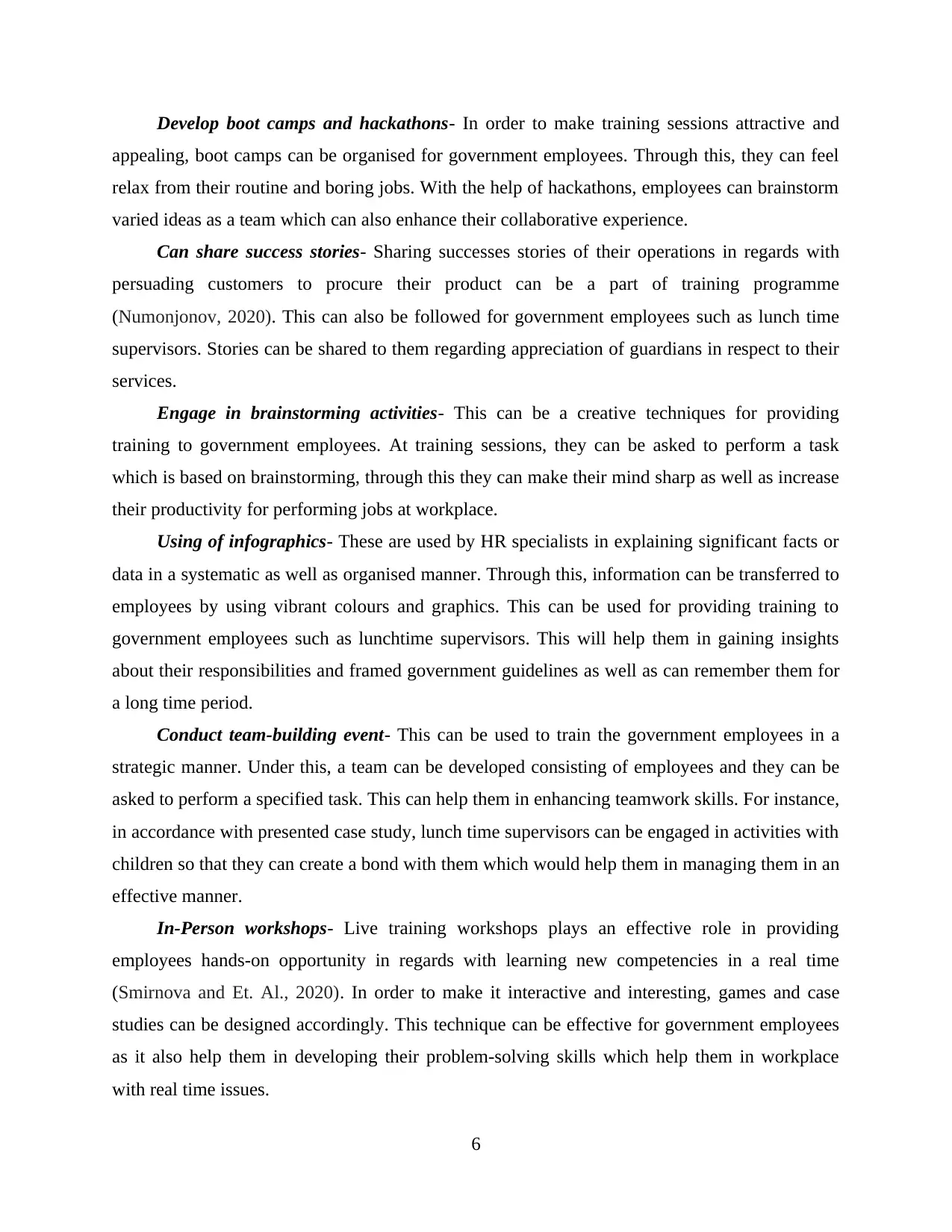
Develop boot camps and hackathons- In order to make training sessions attractive and
appealing, boot camps can be organised for government employees. Through this, they can feel
relax from their routine and boring jobs. With the help of hackathons, employees can brainstorm
varied ideas as a team which can also enhance their collaborative experience.
Can share success stories- Sharing successes stories of their operations in regards with
persuading customers to procure their product can be a part of training programme
(Numonjonov, 2020). This can also be followed for government employees such as lunch time
supervisors. Stories can be shared to them regarding appreciation of guardians in respect to their
services.
Engage in brainstorming activities- This can be a creative techniques for providing
training to government employees. At training sessions, they can be asked to perform a task
which is based on brainstorming, through this they can make their mind sharp as well as increase
their productivity for performing jobs at workplace.
Using of infographics- These are used by HR specialists in explaining significant facts or
data in a systematic as well as organised manner. Through this, information can be transferred to
employees by using vibrant colours and graphics. This can be used for providing training to
government employees such as lunchtime supervisors. This will help them in gaining insights
about their responsibilities and framed government guidelines as well as can remember them for
a long time period.
Conduct team-building event- This can be used to train the government employees in a
strategic manner. Under this, a team can be developed consisting of employees and they can be
asked to perform a specified task. This can help them in enhancing teamwork skills. For instance,
in accordance with presented case study, lunch time supervisors can be engaged in activities with
children so that they can create a bond with them which would help them in managing them in an
effective manner.
In-Person workshops- Live training workshops plays an effective role in providing
employees hands-on opportunity in regards with learning new competencies in a real time
(Smirnova and Et. Al., 2020). In order to make it interactive and interesting, games and case
studies can be designed accordingly. This technique can be effective for government employees
as it also help them in developing their problem-solving skills which help them in workplace
with real time issues.
6
appealing, boot camps can be organised for government employees. Through this, they can feel
relax from their routine and boring jobs. With the help of hackathons, employees can brainstorm
varied ideas as a team which can also enhance their collaborative experience.
Can share success stories- Sharing successes stories of their operations in regards with
persuading customers to procure their product can be a part of training programme
(Numonjonov, 2020). This can also be followed for government employees such as lunch time
supervisors. Stories can be shared to them regarding appreciation of guardians in respect to their
services.
Engage in brainstorming activities- This can be a creative techniques for providing
training to government employees. At training sessions, they can be asked to perform a task
which is based on brainstorming, through this they can make their mind sharp as well as increase
their productivity for performing jobs at workplace.
Using of infographics- These are used by HR specialists in explaining significant facts or
data in a systematic as well as organised manner. Through this, information can be transferred to
employees by using vibrant colours and graphics. This can be used for providing training to
government employees such as lunchtime supervisors. This will help them in gaining insights
about their responsibilities and framed government guidelines as well as can remember them for
a long time period.
Conduct team-building event- This can be used to train the government employees in a
strategic manner. Under this, a team can be developed consisting of employees and they can be
asked to perform a specified task. This can help them in enhancing teamwork skills. For instance,
in accordance with presented case study, lunch time supervisors can be engaged in activities with
children so that they can create a bond with them which would help them in managing them in an
effective manner.
In-Person workshops- Live training workshops plays an effective role in providing
employees hands-on opportunity in regards with learning new competencies in a real time
(Smirnova and Et. Al., 2020). In order to make it interactive and interesting, games and case
studies can be designed accordingly. This technique can be effective for government employees
as it also help them in developing their problem-solving skills which help them in workplace
with real time issues.
6
⊘ This is a preview!⊘
Do you want full access?
Subscribe today to unlock all pages.

Trusted by 1+ million students worldwide
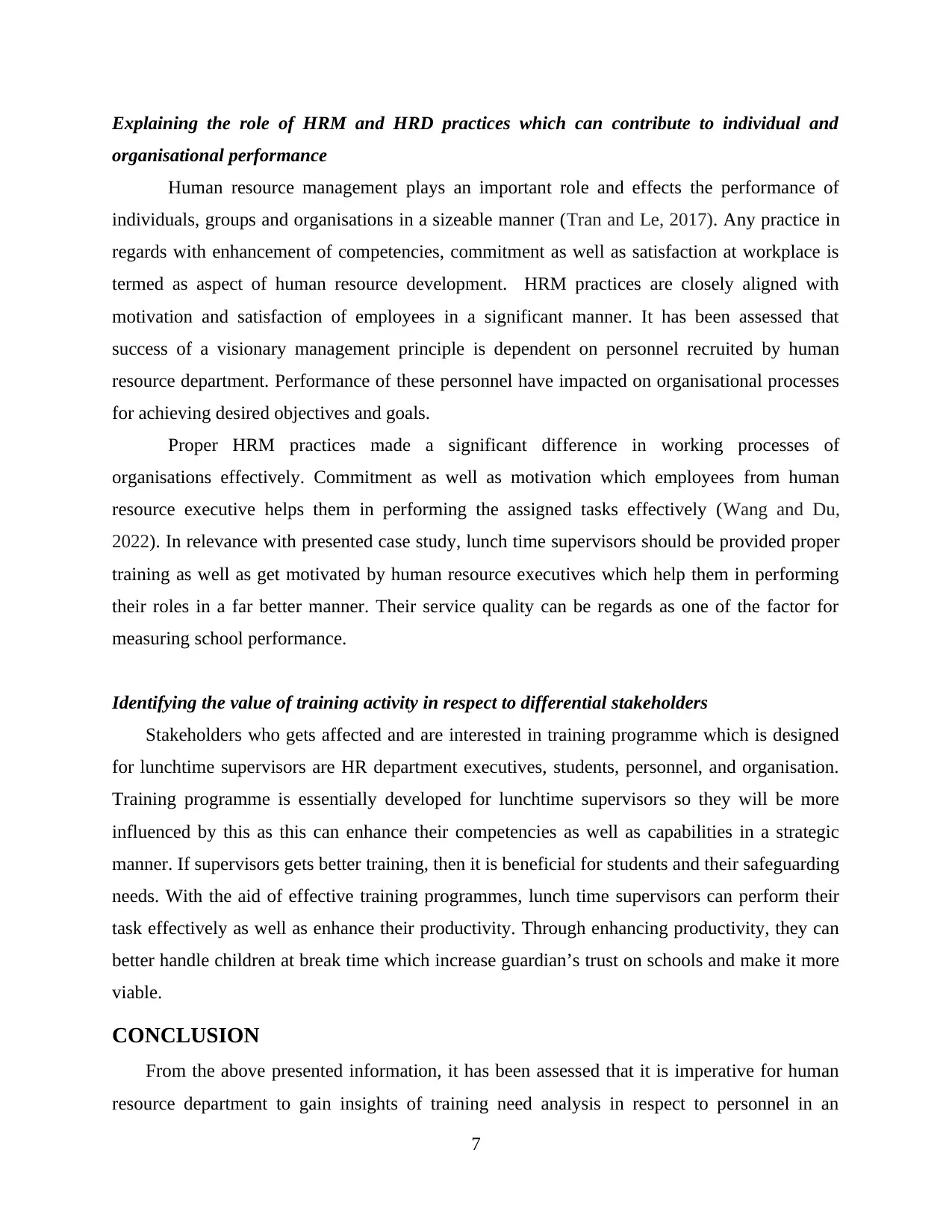
Explaining the role of HRM and HRD practices which can contribute to individual and
organisational performance
Human resource management plays an important role and effects the performance of
individuals, groups and organisations in a sizeable manner (Tran and Le, 2017). Any practice in
regards with enhancement of competencies, commitment as well as satisfaction at workplace is
termed as aspect of human resource development. HRM practices are closely aligned with
motivation and satisfaction of employees in a significant manner. It has been assessed that
success of a visionary management principle is dependent on personnel recruited by human
resource department. Performance of these personnel have impacted on organisational processes
for achieving desired objectives and goals.
Proper HRM practices made a significant difference in working processes of
organisations effectively. Commitment as well as motivation which employees from human
resource executive helps them in performing the assigned tasks effectively (Wang and Du,
2022). In relevance with presented case study, lunch time supervisors should be provided proper
training as well as get motivated by human resource executives which help them in performing
their roles in a far better manner. Their service quality can be regards as one of the factor for
measuring school performance.
Identifying the value of training activity in respect to differential stakeholders
Stakeholders who gets affected and are interested in training programme which is designed
for lunchtime supervisors are HR department executives, students, personnel, and organisation.
Training programme is essentially developed for lunchtime supervisors so they will be more
influenced by this as this can enhance their competencies as well as capabilities in a strategic
manner. If supervisors gets better training, then it is beneficial for students and their safeguarding
needs. With the aid of effective training programmes, lunch time supervisors can perform their
task effectively as well as enhance their productivity. Through enhancing productivity, they can
better handle children at break time which increase guardian’s trust on schools and make it more
viable.
CONCLUSION
From the above presented information, it has been assessed that it is imperative for human
resource department to gain insights of training need analysis in respect to personnel in an
7
organisational performance
Human resource management plays an important role and effects the performance of
individuals, groups and organisations in a sizeable manner (Tran and Le, 2017). Any practice in
regards with enhancement of competencies, commitment as well as satisfaction at workplace is
termed as aspect of human resource development. HRM practices are closely aligned with
motivation and satisfaction of employees in a significant manner. It has been assessed that
success of a visionary management principle is dependent on personnel recruited by human
resource department. Performance of these personnel have impacted on organisational processes
for achieving desired objectives and goals.
Proper HRM practices made a significant difference in working processes of
organisations effectively. Commitment as well as motivation which employees from human
resource executive helps them in performing the assigned tasks effectively (Wang and Du,
2022). In relevance with presented case study, lunch time supervisors should be provided proper
training as well as get motivated by human resource executives which help them in performing
their roles in a far better manner. Their service quality can be regards as one of the factor for
measuring school performance.
Identifying the value of training activity in respect to differential stakeholders
Stakeholders who gets affected and are interested in training programme which is designed
for lunchtime supervisors are HR department executives, students, personnel, and organisation.
Training programme is essentially developed for lunchtime supervisors so they will be more
influenced by this as this can enhance their competencies as well as capabilities in a strategic
manner. If supervisors gets better training, then it is beneficial for students and their safeguarding
needs. With the aid of effective training programmes, lunch time supervisors can perform their
task effectively as well as enhance their productivity. Through enhancing productivity, they can
better handle children at break time which increase guardian’s trust on schools and make it more
viable.
CONCLUSION
From the above presented information, it has been assessed that it is imperative for human
resource department to gain insights of training need analysis in respect to personnel in an
7
Paraphrase This Document
Need a fresh take? Get an instant paraphrase of this document with our AI Paraphraser
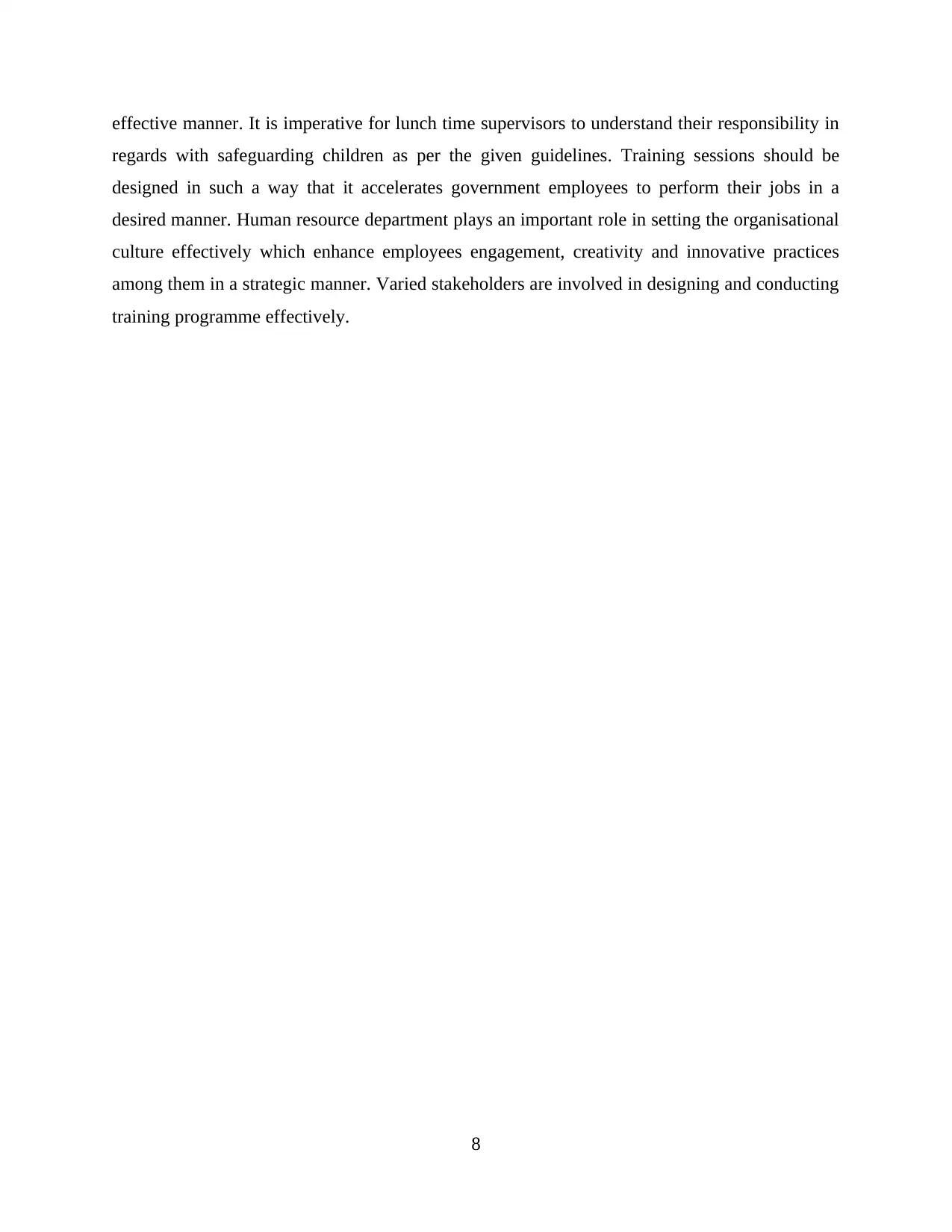
effective manner. It is imperative for lunch time supervisors to understand their responsibility in
regards with safeguarding children as per the given guidelines. Training sessions should be
designed in such a way that it accelerates government employees to perform their jobs in a
desired manner. Human resource department plays an important role in setting the organisational
culture effectively which enhance employees engagement, creativity and innovative practices
among them in a strategic manner. Varied stakeholders are involved in designing and conducting
training programme effectively.
8
regards with safeguarding children as per the given guidelines. Training sessions should be
designed in such a way that it accelerates government employees to perform their jobs in a
desired manner. Human resource department plays an important role in setting the organisational
culture effectively which enhance employees engagement, creativity and innovative practices
among them in a strategic manner. Varied stakeholders are involved in designing and conducting
training programme effectively.
8
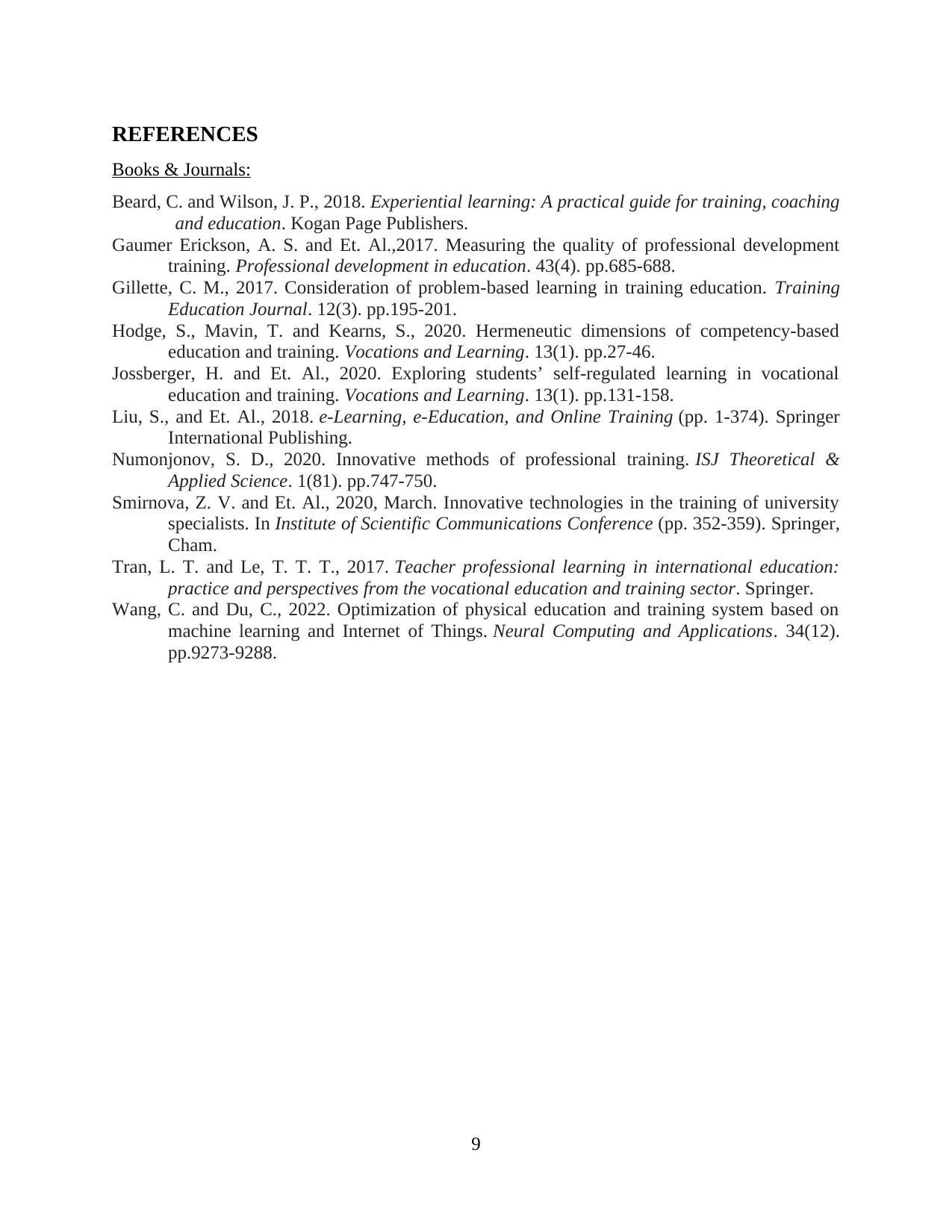
REFERENCES
Books & Journals:
Beard, C. and Wilson, J. P., 2018. Experiential learning: A practical guide for training, coaching
and education. Kogan Page Publishers.
Gaumer Erickson, A. S. and Et. Al.,2017. Measuring the quality of professional development
training. Professional development in education. 43(4). pp.685-688.
Gillette, C. M., 2017. Consideration of problem-based learning in training education. Training
Education Journal. 12(3). pp.195-201.
Hodge, S., Mavin, T. and Kearns, S., 2020. Hermeneutic dimensions of competency-based
education and training. Vocations and Learning. 13(1). pp.27-46.
Jossberger, H. and Et. Al., 2020. Exploring students’ self-regulated learning in vocational
education and training. Vocations and Learning. 13(1). pp.131-158.
Liu, S., and Et. Al., 2018. e-Learning, e-Education, and Online Training (pp. 1-374). Springer
International Publishing.
Numonjonov, S. D., 2020. Innovative methods of professional training. ISJ Theoretical &
Applied Science. 1(81). pp.747-750.
Smirnova, Z. V. and Et. Al., 2020, March. Innovative technologies in the training of university
specialists. In Institute of Scientific Communications Conference (pp. 352-359). Springer,
Cham.
Tran, L. T. and Le, T. T. T., 2017. Teacher professional learning in international education:
practice and perspectives from the vocational education and training sector. Springer.
Wang, C. and Du, C., 2022. Optimization of physical education and training system based on
machine learning and Internet of Things. Neural Computing and Applications. 34(12).
pp.9273-9288.
9
Books & Journals:
Beard, C. and Wilson, J. P., 2018. Experiential learning: A practical guide for training, coaching
and education. Kogan Page Publishers.
Gaumer Erickson, A. S. and Et. Al.,2017. Measuring the quality of professional development
training. Professional development in education. 43(4). pp.685-688.
Gillette, C. M., 2017. Consideration of problem-based learning in training education. Training
Education Journal. 12(3). pp.195-201.
Hodge, S., Mavin, T. and Kearns, S., 2020. Hermeneutic dimensions of competency-based
education and training. Vocations and Learning. 13(1). pp.27-46.
Jossberger, H. and Et. Al., 2020. Exploring students’ self-regulated learning in vocational
education and training. Vocations and Learning. 13(1). pp.131-158.
Liu, S., and Et. Al., 2018. e-Learning, e-Education, and Online Training (pp. 1-374). Springer
International Publishing.
Numonjonov, S. D., 2020. Innovative methods of professional training. ISJ Theoretical &
Applied Science. 1(81). pp.747-750.
Smirnova, Z. V. and Et. Al., 2020, March. Innovative technologies in the training of university
specialists. In Institute of Scientific Communications Conference (pp. 352-359). Springer,
Cham.
Tran, L. T. and Le, T. T. T., 2017. Teacher professional learning in international education:
practice and perspectives from the vocational education and training sector. Springer.
Wang, C. and Du, C., 2022. Optimization of physical education and training system based on
machine learning and Internet of Things. Neural Computing and Applications. 34(12).
pp.9273-9288.
9
⊘ This is a preview!⊘
Do you want full access?
Subscribe today to unlock all pages.

Trusted by 1+ million students worldwide
1 out of 9
Related Documents
Your All-in-One AI-Powered Toolkit for Academic Success.
+13062052269
info@desklib.com
Available 24*7 on WhatsApp / Email
![[object Object]](/_next/static/media/star-bottom.7253800d.svg)
Unlock your academic potential
Copyright © 2020–2025 A2Z Services. All Rights Reserved. Developed and managed by ZUCOL.

